![]() SPREAD
POSITIONS
SPREAD
POSITIONS
The purpose of this lesson is to follow along and recreate the strategies
developed here.
The third type of strategy is called a spread position.
A spread is
a portfolio of calls (a call spread) or a portfolio of puts (a put
spread). In a call
spread, you buy and sell different call options.
If they differ only by the strike price, this would be a vertical call spread. The
term vertical comes from the way option prices are sometimes reported.
The different strike prices are listed vertically, and the maturities are
listed horizontally, as in the
following Table.
Option
Price Reporting and Vertical/Horizontal Spreads
|
|
Expiration
Date 1 |
Expiration
Date 2 |
|
|
Strike
1 (K1)
|
Option
Price |
Option
Price |
|
|
Strike
2 ( |
Option
Price |
Option
Price |
|
Following this terminology, a horizontal
(or calendar) spread would fix the strike price (K) but vary the expiration date.
A diagonal spread
would vary both strike price and expiration date.
Spreads come in two other varieties: bullish and bearish.
As the names imply, if you
(mainly) make money
when the
price of
the underlying security
rises, you have a bullish position; and if you mainly make money when the price
falls, you have a bearish position. These
positions are shown in following Figures 1-4.
Figure 1
Bullish
Call Spread
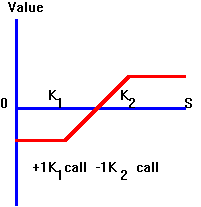
Figure 2
Bearish
Call Spread
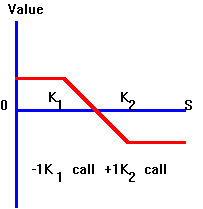
Figure 3
Bullish
Put Spread
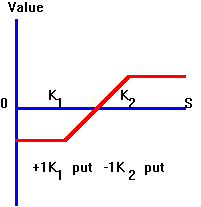
Figure 4
Bearish
Put Spread
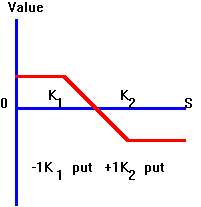
Other types of spread positions are ratio
spreads, where the ratio is the number of calls (puts) bought at a higher
strike per call (put) sold at a lower strike.
The writer of such a portfolio has a ratio back spread. Figures
5 and 6 show the payoffs from a -1:2 call ratio spread and a 2:-1 put ratio
spread. Observe that in these
positions a floor is imposed upon possible losses, whereas the position
participates in any upside gain. In
the -1:2 call ratio spread depicted in Figure 8.10, no upper bound is imposed on
the upside potential.
Figure
5
-1:2
Call Ratio Spread
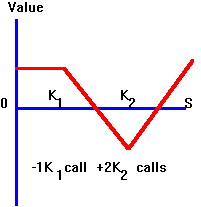
The 2:-1 put spread in Figure 6 imposes an upper bound on the upside
gain.
Figure
6
2:-1
Put Ratio Spread
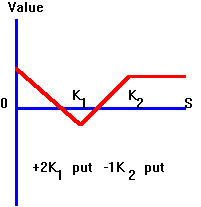
Spreads can also be used to make profits when prices are expected to
remain in a stable range. A famous
example of this is the butterfly spread,
which consists of buying a low and high strike-price call and selling two medium
strike-price calls. The payoff from
this position is depicted in the following Figure 7.
Figure 7
Call
Butterfly Spread
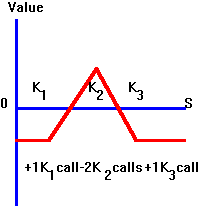
The position in Figure 7 can also be engineered by selling the medium
puts and buying the extreme strike-price puts, as shown in the following Figure
8.
Figure 8
Put
Butterfly Spread
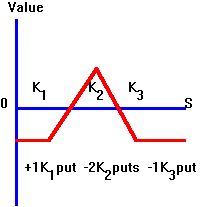
Calendar, or horizontal, spreads are difficult to illustrate, as
the expiration dates of the options are
different. However, you can
view the payoffs from such strategies in Option Tutor.
An option pricing model such as the Black-Scholes
lets you value the long-dated option at the expiration date of the short-dated
option, and examine the resulting payoffs as a function of the underlying stock
price.
OS
Financial Trading System,
Restart
to return home
©2003
OS Financial Trading System